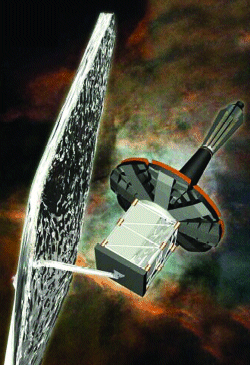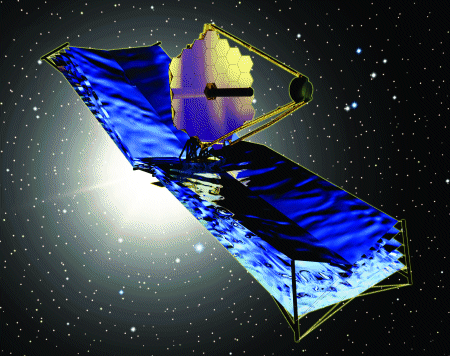TIM FURNISS / LONDON
NASA wants its next-generation space telescope to give a glimpse of the birth of the universe - but technological challenges first have to be overcome
Could scientists ever see the actual formation of a galaxy? The successor to the Hubble Space Telescope (HST) is intended to bring that day a step closer. NASA is poised to award a $500 million contract to either Lockheed Martin or TRW/Ball Aerospace to build the Next Generation Space Telescope (NGST). With it the agency wants to peer into a previously unobserved region of the universe, with the hope of showing the first stars and galaxies being formed (Flight International 30 October-5 November)
NASA's Goddard Space Flight Center, Maryland, which manages the six-year-old NGST project, says that the biggest challenges have been programmatic rather than technical. "The partnership aspects are daunting," says project manager Bernard Seery. "Holding to schedule has been the biggest challenge."
The NGST is the flagship of NASA's Origins programme and is a co-operative venture with the European Space Agency, Canadian Space Agency, industry and academia. The new telescope is tentatively set for launch between December 2008 and June 2009 after the HST has been retired.
Between the competitors, Lockheed Martin has the advantage of having built the HST, but TRW has experience with esoteric mirror systems developed for National Reconnaissance Office (NRO) satellites.
The fundamental objective of Lockheed Martin's submission "has been to define an overall architecture that exhibits sufficient performance, cost and scheduled credibility," says Jeff Harris, president of Lockheed Martin Space Systems. On the competing TRW side, Dave Shuckstes, the company's NGST programme manager says: "NGST offers the TRW-led team an opportunity to do what it does best: design, build and deploy and manage a high reliability and high precision instrument."

The 6m (20ft) NGST mirror, which must operate in low temperatures required for the infrared cameras, could be based on technology used in an ultralight 530mm diameter, 1kg (2.2lb) mirror developed for the NRO. The mirror has a 1mm-thick aluminium-coated reflective glass membrane facesheet developed by the University of Arizona, part of the Lockheed Martin team.
Other potential mirrors are under study by Composite Optics, the NASA Marshall Space Flight Center (MSFC) and Ultramet. Composite Optics is working on reinforced glass materials, which behave well in cryogenic conditions. The MSFC's nickel alloy mirror - favoured by TRW - is less likely to fracture, while Ultramet's silicon carbide mirror is mounted on a layer of siliconcarbide foam.
The NGST's primary mirror will not have the luxury of being massive and retaining its perfect shape through material stiffness. The reflective surface's stability will be computer-controlled via actuators which can adjust the mirror's shape to maintain high image quality. The actuators have to work at the NGST's cryogenic operating temperatures, aligning the primary and secondary mirror segments and controlling the instrument. NASA has sponsored external studies to develop the required technology.

Going further
The NGST "will have functions beyond any other astronomical observation unit ever created", says Graham Fiorani, co-author of a University of Michigan engineering review of the project. The super-cooled 5,400kg NGST has much to live up to. It will use far-visible to mid-infrared radiation imaging and spectroscopic instruments. The TRW telescope would be put in a solar orbit 1.6 million km from Earth - away from Earthshine, while the Lockheed Martin craft would be in traditional Earth orbit.
The new telescope will be able to see objects 400 times fainter than currently possible with the largest ground-based telescopes or space-based infrared satellites, with a spatial resolution, or sharpness, equalling or surpassing the HST's. "The design of the Lockheed mirror does not take advantage of all the possible technologies that can be added to make the instrument better, but is the simplest and most cost efficient," says Fiorana. The TRW design "is the most advanced and more costly but will offer more versatility in its observations".
Astronomers observe the universe by studying the electromagnetic spectrum which includes gamma, X-ray, ultraviolet, visible light, infrared and microwave and radio radiation. Visible light, short wavelength radio waves and some infrared light penetrates the atmosphere and can be observed on the ground, but spacecraft are required to monitor other wavelengths from outside the atmosphere. Microwave and radio astronomy can be used to examine objects much further away and radio waves can travel through obstacles such as dust clouds without being distorted.
Ultraviolet observations are useful for looking at material surrounding objects rather than the objects themselves. Interstellar media such as X-ray astronomy looks at energetic bodies that emit huge quantities of X-rays, such as black holes and neutron stars. Gamma rays can provide information of the properties of high- energy bodies such as supernovas pulsars and quasars. Cosmic rays are the most powerful form of radiation and can be studied to monitor supernova explosions to nearby solar events.
Visible light images can give the world a clear view of the universe seen by the human eye. Infrared is especially important for looking for cool objects such as dust clouds and dead stars.
It is the far-visible and near-infrared region in which astronomers hope to see the components of the universe when they were under development. The farthest back in time that can be seen is about 300,000 years after the Big Bang because before then the universe was too hot and opaque. The cosmic background radiation was released 300,000 years after the Big Bang.
The NGST "will be optimised for the infrared because the expansion of the universe will redshift the light of the most distant objects into the infrared", says astronomer Ian Ridpath, editor of the Oxford Dictionary of Astronomy.
Age-old question
But astronomers are struggling to work out the age of the universe, with estimates of 15 billion years the most popular. "There is, of course, no 'right' answer to the question - just a 'best guess'," says Ridpath. "The current 'best guess' for the age of the universe is 13-14 billion years, but 15 will do as a round figure."
Although the universe is believed to have evolved from an apparent "Big Bang" of primordial material, questions remain because few signs of its development are evident, in contrast to many apparent signs of a fully-developed universe that was perhaps created instantly.
One spectacular image by HST in 1996 of the "beginning of time" - which at that time was thought to be 12 billion years ago, according to NASA - shows perfectly formed galaxies, puzzling scientists who had expected to see galaxy development at work. But astronomers say the earliest galaxies are now believed to have formed within only about a billion years of the Big Bang. Recent HST images, for example, show the apparent discovery of galactic building blocks within a few hundred million years of the Big Bang .
NASA wants to know how galaxies evolve, understand the shape of the universe, the interaction of stars and planetary systems, the life cycles of matter in the universe and study "dark matter". Another objective is to gain an understanding of quantum mechanics, the supporting argument beneath many scientific theories. NASA hopes that the more is learned about quantum mechanics, the more the scientific theories will become fact.
A final objective of the Origins programme is to answer the question of life beyond Earth and the NGST is expected to find planetary systems around stars - though this does not necessarily mean that these will support life.
Source: Flight International























